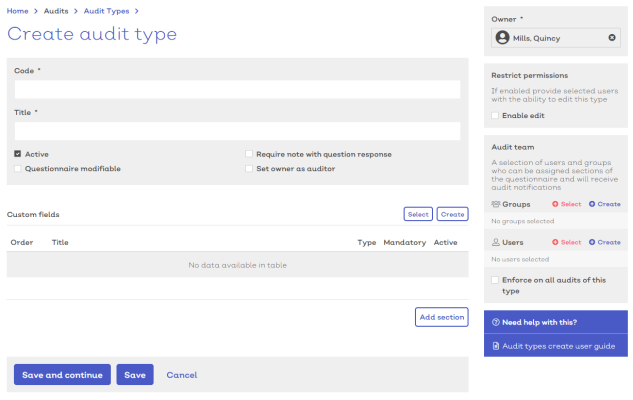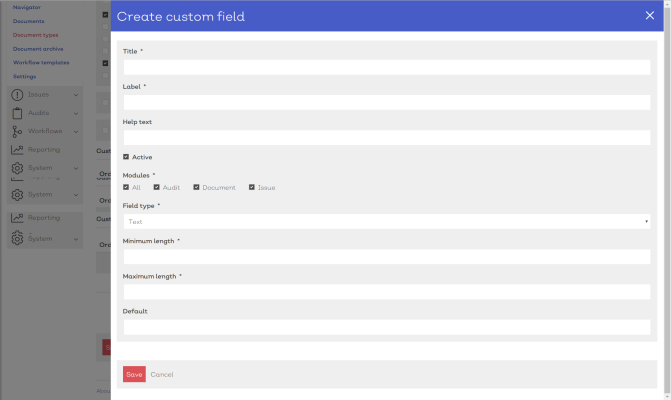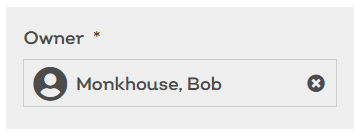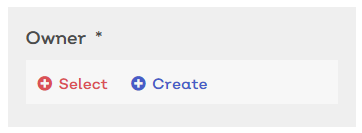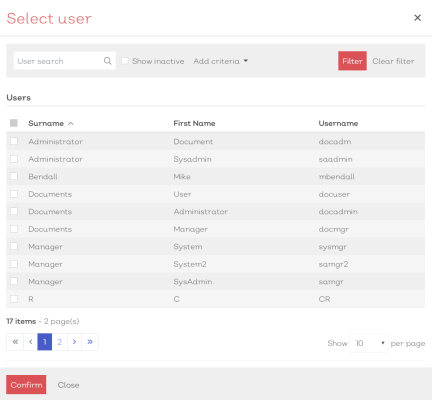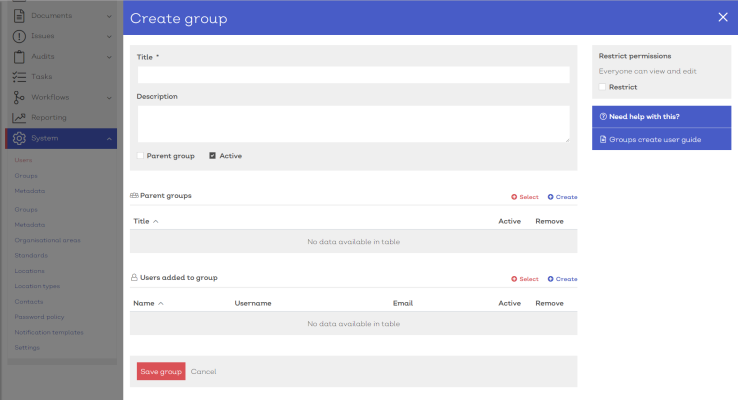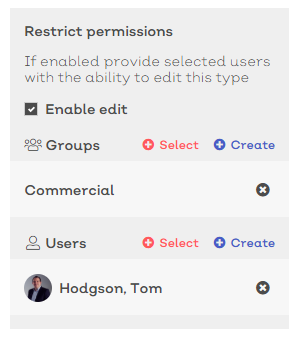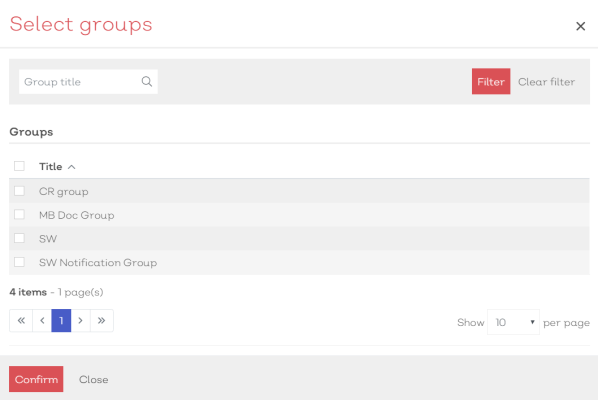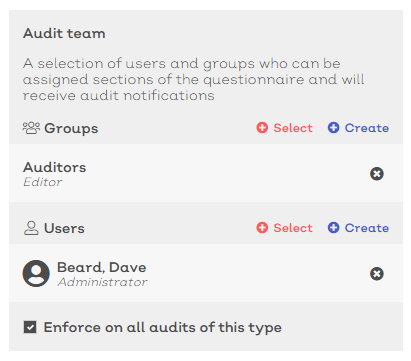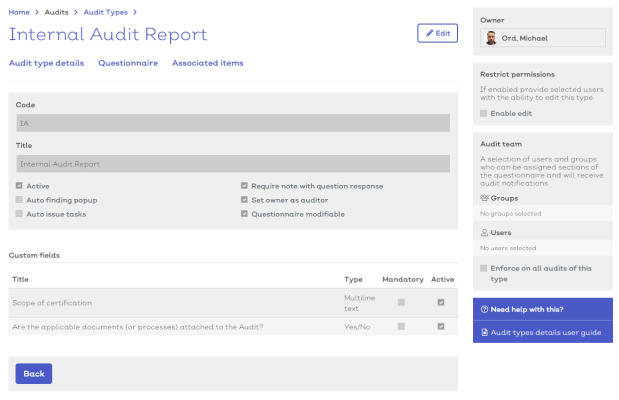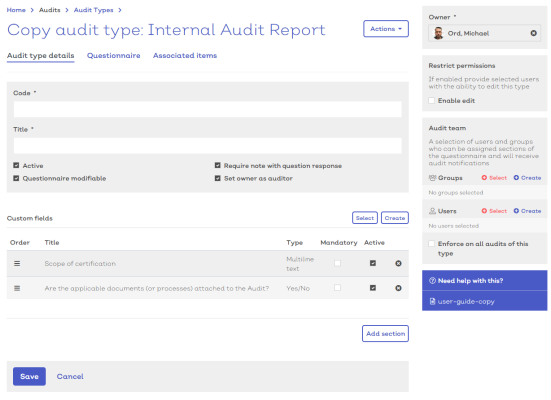Audit types
Audience: Audit administrators, Audit Managers with Type permissions
List | Create New | View Details | Edit | Copy
Statuses | Dates | Settings | Custom Fields | Owners | Audit team
Audit types are the templates used to define the requirements, permission and questionnaire requirements for the different types of audit that you carry out in the EQMS system. This could be anything from Quality management and process reviews to daily checks and inspections.
Each type consists of the key details, questionnaire (if required), settings, default audit team, notifications and any custom fields that your audits require.
Audit type list
- To view, create and edit audit types, navigate to Home > Audits > Audit types. You should be presented with a screen similar to below:
[click image to expand]
- Select any option from the list to view the details.
- Standard list screen filters and Export available.
- Additional filter of 'Show my types' available. If this box is checked, the list will only display audit types you own
- 'Show inactive' will include any records currently marked as inactive in the list results.
Selecting the options icon [![]() ] at the end of each row will reveal how you can interact with the record.
] at the end of each row will reveal how you can interact with the record.
For audit types, the options are**:
| Option | Description |
|---|---|
| View | Select to view the details screen |
| Edit | Select to enter the audit type details edit screen |
| Copy | Select to use the audit type as a template for a new audit type |
**Permissions apply
Create new audit types
To create a new Audit type:
- Navigate to Home > Audits > Audit types.
-
Select
Create. You should be presented with a screen similar to below:
[click image to expand]
- Provide a suitable code and title for the audit type.
Note: A unique combination of code and title is required for each audit type.
- Next, you can amend the settings for the audit type by checking or un-checking the relevant checkbox.
(Checked = enabled, Unchecked = disabled)
| Setting | Description |
|---|---|
| Active | A record must be set as active for it to be selected in the system |
| Require note with question response |
|
| Questionnaire modifiable |
|
| Set owner as auditor | Automatically sets the audit record owner as the auditor for the record. |
- The next section allows you to add any additional custom fields that you need to ensure that all required data is captured. These can be split into different sections.
- Down the right hand side of the screen are options for defining the default Audit owner and Audit team
- Select Save to confirm the creation of your new audit type
- Or, select Save and continue to create the new audit type and begin associating additional items and creating the questionnaire.
For a full breakdown of each of these options, see below:
Custom fields allow you to build out the rest of your Audit type to ensure that all of the data you require is being captured by the responsible people and is in the format you need for your reports. These custom fields can be split into sections for both presentation and permission purposes.
[click image to expand]
Add custom field sections
If you are going to have several custom fields added to the details of audits of this type, they can be split into sections for both presentation and permissions purposes.
To add a section, simply:
- Select the Add section button
- Provide a title for the section
To associate a custom field:
- Select
 Select in the section you want to add the field to. This will present you with a Select custom field modal similar to below:
Select in the section you want to add the field to. This will present you with a Select custom field modal similar to below:
[click image to expand]
-
Use the Select custom field modal to find the required field(s)
-
Once located, check the box in the far left of the suitable row(s)
-
Select confirm to associate the custom fields to the audit type
- Select
Create. A create new custom field panel will slide into view, similar to below:
[click image to expand]
- Follow the instructions here to create the new custom field
Note:
Permissions apply. If you do not have permission to create new custom fields, the Create option will not be available to you
Owners are users who are specified as the key stakeholder of an item, record or type within EQMS. Audit types allow you to select an owner for the overall type.
[click image to expand]
The owner of a type will automatically default to the current user creating the Audit Type.
To change this:
- Select the remove icon
 next to the owner's name. This will now present you with a blank owner field, similar to below:
next to the owner's name. This will now present you with a blank owner field, similar to below:
[click image to expand]
- Click
 Select to reveal a user selection modal, similar to below:
Select to reveal a user selection modal, similar to below:
[click image to expand]
-
Use the Select user modal to find the required user
-
Once located, check the box in the far left of the suitable row
-
Select confirm to associate the user to the audit type as the new audit type owner
- Select
Create. A create new user panel will slide into view, similar to below:
[click image to expand]
- Follow the instructions here to create the new user
Note:
Permissions apply. If you do not have permission to create new groups or users, the Create option will not be available to you
Audit types can be restricted so that only users within a defined group can view, edit or manage. You can define the audit type permissions down the right hand side column of the details screen, similar to below:
[click image to expand]
To allow specific groups or users to edit the audit type
- Tick the Enable edit check box in the Restrict permissions box in the right hand side column of the screen.
- Select
 Select in the Groups or Users section. This will present you with a Select group or user modal similar to below:
Select in the Groups or Users section. This will present you with a Select group or user modal similar to below:
[click image to expand]
-
Use the Select group/user modal to find the required group(s)/user(s)
-
Once located, check the box in the far left of the suitable row(s)
-
Select confirm to associate the group(s)/user(s) to the audit type
Note:
Any user or group given permission here must also have at least Audit User level permissions granted by a System Administrator to be able to access Audit records.
- Select
Create. A create new group/user panel will slide into view, similar to below:
[click image to expand]
Note:
Permissions apply. If you do not have permission to create new groups or users, the Create option will not be available to you
An audit team is a group of users and system groups that are granted permission to View, Edit or Delete audits of this type. Additionally, members of the audit team will receive relevant notifications for records of this type.
You can define the permissions in the Audit team section of the right hand side column of the Audit type details screen, similar to below:
[click image to expand]
To restrict the audits of this type
- Tick the Restrict check box in the Restrict permissions box in the right hand side column of the screen.
- To enforce these settings across ALL audits of this type, tick the Enforce on all audits of this type check box
- Select
 Select. This will present you with a Select group/user modal similar to below:
Select. This will present you with a Select group/user modal similar to below:
[click image to expand]
-
Use the Select group/user modal to find the required group(s)/user(s)
-
Once located, check the box in the far left of the suitable row(s)
-
Select confirm to associate the group(s)/user(s) to the audit type
-
Once a group or user is selected decide what permissions they will have:
| Option | Description |
|---|---|
|
Viewer |
Can only view the audits |
|
Editor |
Can edit audits of this type |
|
Creator |
Can create/raise new audits of this type |
|
Administrator |
Can do anything to this record completely unrestricted |
- Select
Create. A create new group/user panel will slide into view, similar to below:
[click image to expand]
Note:
Permissions apply. If you do not have permission to create new groups or users, the Create option will not be available to you
View audit type details
Viewing the audit type gives you a read-only view of the permitted details and the activity feed.
To access the audit type details screen:
- Navigate to Home > Audits > Audit types and either:
- Select view from the more options button [
 ]in the list screen
]in the list screen - If you have read-only access to an Audit type you can simply select the type from the list
- Select view from the more options button [
You should be greeted with a screen similar to below:
[click image to expand]
The details screen will list all key details to do with the audit type including custom fields, associated items, permissions and notifications.
Note:
- The details screen is read only and all fields should be greyed out.
- Select the edit icon in the top right to access the edit details screen
.
Edit existing audit types
To edit an existing audit type:
- Navigate to Home > Audits > Audit types.
- Either:
- Select an Audit type from the list to view the edit screen
- Select Edit from the options icon [
 ] in the relevant row
] in the relevant row
- For more information on audit details, see above
- To remove any information, select the delete icon next to the relevant data in the details screen
Copy audit types
EQMS allows you to copy an existing audit type to use as a base template for a new audit type. This reduces the time required when creating multiple similar audit types.
To copy an existing audit type:
- Navigate to Home > Audits > Audit types.
- Either:
- Select an audit type from the list to view the edit screen and select Copy from the more options icon [
 ]
] - Select Copy from the options icon [
 ] in the relevant row in the list screen
] in the relevant row in the list screen
- Select an audit type from the list to view the edit screen and select Copy from the more options icon [
This will reveal a new audit type details screen with all core details from the copied audit type contained within including any associated custom fields, permissions and notification groups.
[click image to expand]
- Complete the details for the new audit type by amending any of the existing fields. For more information on creating a new audit type, see above

